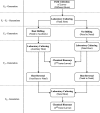Switching among natal and auxiliary hosts increases vulnerability of Spodoptera exigua (Hübner) (Lepidoptera: Noctuidae) to insecticides
- PMID: 28428863
- PMCID: PMC5395457
- DOI: 10.1002/ece3.2908
Switching among natal and auxiliary hosts increases vulnerability of Spodoptera exigua (Hübner) (Lepidoptera: Noctuidae) to insecticides
Abstract
The role of insecticidal application and host plant resistance in managing Spodoptera exigua has been well documented, but the effect of different host plants, on which the pest cycles its population in the field, has seldom been investigated. Therefore, we have studied the vulnerability of S. exigua against commonly used insecticides (cypermethrin, chlorpyrifos, lufenuron, and emamectin benzoate) with different mode of actions when it switches its generations from natal to auxiliary hosts and vice versa. Different field populations being established on different host plants including castor, cauliflower, cotton, okra, and spinach were collected and reared in the laboratory before insecticidal bioassays. The role of larval diet and host plant switching on their response to tolerate applied insecticides was studied using leaf-dip bioassay methods. Host switching demonstrated a significant role in altering the vulnerability of S. exigua populations to tested insecticides. Spodoptera exigua sourced from castor, when switched host to okra and spinach, exhibited 50% higher mortality when treated with emamectin benzoate. This trend in mortality was consistent upon complete host switch cycle (natal-auxiliary-natal host). However, the highest increase (92%) in vulnerability was recorded when the larvae were shifted to spinach from cotton. In general, chlorpyrifos and lufenuron had highest efficacies in terms of larval mortality. The findings of present studies provide insights to a better understanding the behavior of polyphagous pests and the role of different host plants in altering the susceptibility of these pests against applied insecticides. Ultimately the results warrant that due consideration should be given to cropping patterns and time of host switching by pest population during planning and executing chemical control.
Keywords: beet armyworm management; castor; cauliflower; cotton; host switching; integrated pest management; natal versus auxiliary hosts; okra; polyphagous; spinach.
Figures




References
-
- Abbas, N. , Shad, S. A. , & Razaq, M. (2012). Fitness cost, cross resistance and realized heritability of resistance to imidacloprid in Spodoptera litura (Lepidoptera: Noctuidae). Pesticide Biochemistry and Physiology, 103, 181–188.
-
- Adamski, Z. , Niewadzi, M. , & Ziemnicki, K. (2005). Inheritance of chorionic malformations and insecticide resistance by Spodoptera exigua . Journal of Applied Entomology, 129, 526–533.
-
- Adamski, Z. , Ziemnicki, K. , Marciniak, P. , Halamunda, J. , Nawrocka, M. , Lelario, F. , … Bufo, S. A. (2009). Effect of various xenobiotics on hatching success of Spodoptera exigua eggs as compared to a natural plant extract. Journal of Toxicology and Environmental Health, Part A, 72, 1132–1134. - PubMed
-
- Ahmad, M. , Arif, M. I. , & Ahmad, M. (2007). Occurrence of insecticide resistance in field populations of Spodoptera litura (Lepidoptera: Noctuidae) in Pakistan. Crop Protection, 26, 809–817.
-
- Ahmad, M. , Ghaffar, A. , & Rafiq, M. (2013). Host plants of leaf worm, Spodoptera litura (Fabricius)(Lepidoptera: Noctuidae) in Pakistan. Asian Journal of Agriculture and Biology, 1, 23–28.
LinkOut - more resources
Full Text Sources
Other Literature Sources

